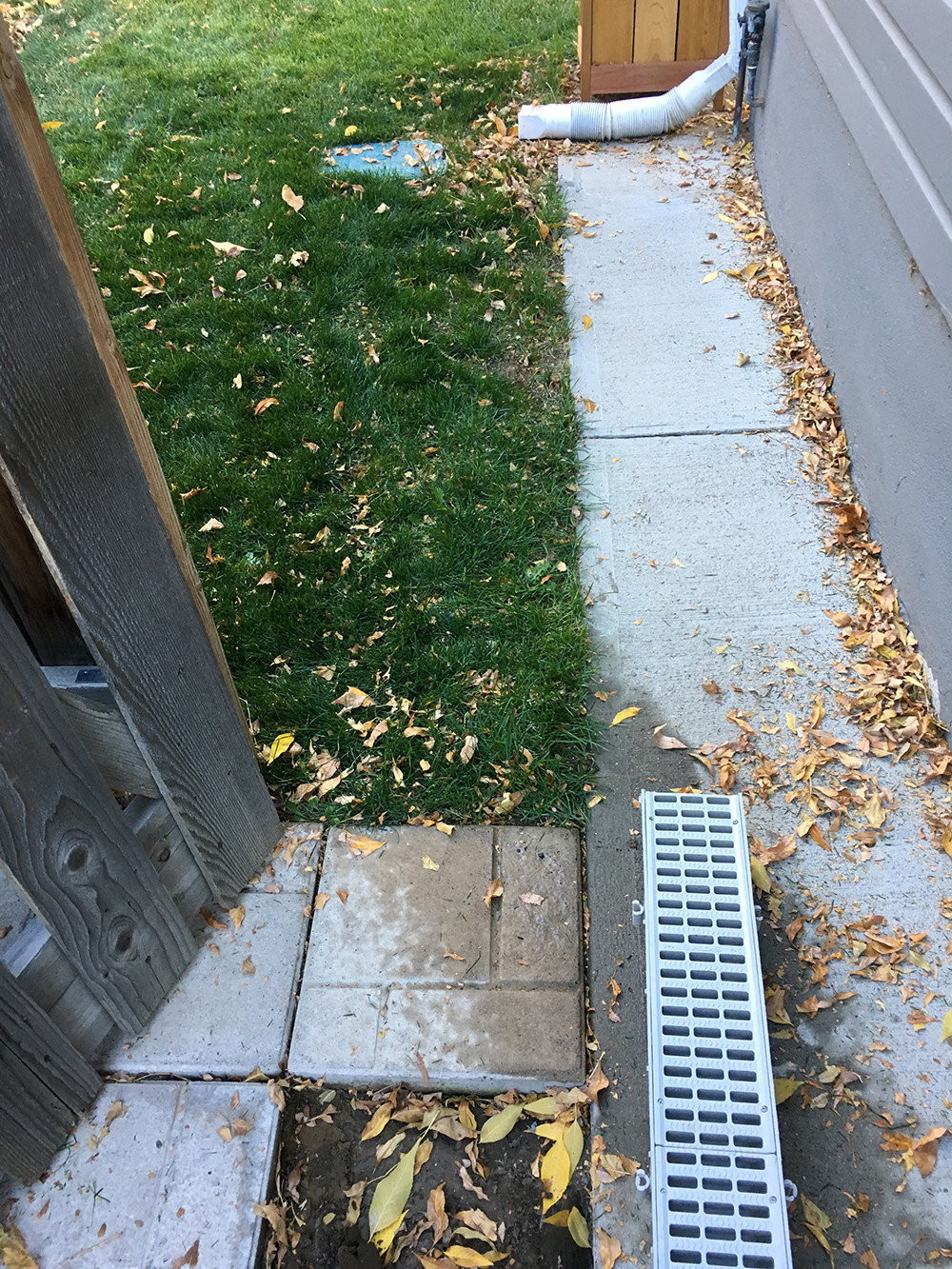It is difficult to see the slopes but it looks as if your problem begins at the bottom step on the left. The slope is towards your foundation. Very bad.
I would take up all of the CMU on the right side of this picture, right foreground corner all the way to the turf. Regrade the soil so the slope is away from your foundation making sure to meld into your neighbor's contours.
You want to remove enough soil to be replaced by mason's sand at least 1" and compact and allow 2% slope from the bottom of your foundation to your neighbor's (their elevations, contours and drainage have to be taken into consideration).
You need that plastic edging for this type of installation of pavers on a compacted sand bed, no concrete or grout or spaces between paver edges. This edging is secured with long spikes similar to railroad spikes and ensures those units, the tightly installed concrete pavers do not shift or spread. It would be installed on the farthest right of the picture and on your side of that fence. Allow absolutely no space between the pavers! You will need a hard rubber mallet for this work.
Ideally you would take that section of fence down and work with both your property and your neighbor's. Remove enough soil to allow water to drain away from both foundations then an inch or two lower so you can make a sand base 1 or 2" deep (compacted) for the pavers to sit upon. Bottom of fence should not touch the soil or plant material.
This is a rough idea of a solution but need to know what is happening in terms of grade and obstructions on the neighbor's property, do you have an 'as-built' with your mortgage papers that shows property lines, the footprint of your home, utilities and hopefully a few elevations? If this makes sense to you the equation is Rise/Run= Slope and sq. ft. of surface area/81 = yards necessary for 4" depth for soil, mulch, rock. Otherwise, I can explain in more detail.
I need to add a bit more to this answer. For water to be getting into your basement at all means there might not be a foundation drain pipe or an incorrectly installed drain pipe that should be all around the perimeter of your basement footing or the concrete that is below the surface was not protected by an asphalt coating. There should never be a slope that allows surface water to drain TOWARDS the foundation. A fix would be tearing up all paving and regrading the soil away from your home into a swale sloped to carry water away from your home.
This bad drainage issue greatly reduces the value of your home compounded by the moisture in the basement causing the wood of your home to rot. This is a big deal. This is also a health issue with mold! It would be worth the money and effort to correct this drainage problem. Where do you live?
Here in the States when a contractor builds a home (and doesn't say in his contract 'in lieu of the State of Washington's (ie.) warranty'), the law says that contractor is responsible for any problems that happened because of his work or the lack of it FOR TWELVE YEARS, 6 for discovery and 6 to get it fixed. It gets tricky when the home is sold to someone else within the 6 year limit for discovery. If you had had this home built, original owner 12 years ago, that contractor would have to come fix it on his dime. Good thing to check into.
You aren't thinking about subsurface water. There is far more subsurface water that is constantly flowing towards your basement than you know. Your basement is sitting in a pool of water only held back by rotting concrete. And again, the mold this causes can actually be deadly.
A foundation drain should be a 4" diameter perforated pipe that is placed outside the footing not on top of it, runs all around the perimeter of your home with drain rock, landscape fabric and proper sloping to carry any subsurface water away to the sewer. It is usually against the law to daylight any subsurface water. That means water coming out of a pipe to daylight downhill on the surface of any property. Nothing should ever be drained INTO this foundation drain. Take a look at your documents, check with Buildings and Code (don't tell them who you are just yet), find the original contractor or hire another one to dig down and check what is or isn't where it should be.
Let me know, this is kinda my arena of expertise. I used to build custom homes (29 in 8 years). We just went through a nightmare with our own custom home and a daylight basement!! I lived on site and threw tantrums to get the foundation contractor up to speed on 9' stem walls. I remember coming back from town to find this idiot starting to backfill and he had just thrown the pipe in, no sloping, no drain rock, no asphalt coating on the concrete and it was on top of the footing not beside it. I had to stand right there and direct this sub to do his job correctly. I got my 'Construction Bible' out and educated him. And that is just one day of an on going nightmare.
You might have some rights you need to learn and use!! Get a construction inspector. You have an investment and it is rotting away.




